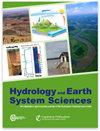突然地震扰动导致森林流域暴雨流阈值行为的非平稳性增加
IF 5.8
1区 地球科学
Q1 GEOSCIENCES, MULTIDISCIPLINARY
引用次数: 0
摘要
摘要极端地震对局地和区域景观植被的干扰会迅速破坏原有的水文功能,极大地增加了预测降雨径流过程阈值行为的挑战,以及水文系统的复杂性。目前尚不清楚,在持续的大地震破坏下,滑坡和植被演化之间的长期相互作用是如何调节流域水文行为的。在一个著名的受汶川地震影响的流域,用两个线性段的阈值来研究非线性水文行为。地震后局部滑坡区上升阈值(THr)较低(210.48 mm),比未受干扰的森林和草地灌丛区有更快的暴流响应速率,容易引发特大山洪灾害。此外,提出了一个具有不同土地利用、生态和地理区域的综合响应度量对(综合流域平均生成阈值THg - IWA和上升阈值THr - IWA),并有效地应用于识别流域紧急水文行为。对地震前后两个综合水文阈值的年际变化进行了评估,以检测水文极值和非线性径流响应的时间非平稳性。2011年是震后水文扰动恢复时间尺度上的一个重要转折点,震后滑坡演化在空间上达到了极端的异质性状态。此时THr−IWA值较震前下降了~ 9 mm。这与山体滑坡的快速扩张密切相关,导致变源区域从河道向邻近山坡的更大范围延伸,并加速地下暴雨流,导致山洪暴发。最后,我们提出了一个概念模型,解释地震引起的滑坡和植被之间的短期和长期相互作用如何在事件时间尺度上影响洪水线,从而产生增加的非平稳水文行为。这项研究扩展了我们目前对基于阈值的水文和非平稳风暴流行为的知识,以响应突发性地震干扰,用于预测未来的洪水状态。本文章由计算机程序翻译,如有差异,请以英文原文为准。
Increased nonstationarity of stormflow threshold behaviors in a forested watershed due to abrupt earthquake disturbance
Abstract. Extreme earthquake disturbances to the vegetation of local and regional
landscapes could swiftly impair the former hydrologic function,
significantly increasing the challenge of predicting threshold behaviors of
rainfall–runoff processes as well as the hydrologic system's complexity over
time. It is still unclear how alternating catchment hydrologic behaviors
under an ongoing large earthquake disruption are mediated by long-term
interactions between landslides and vegetation evolution. In a well-known watershed affected by the Wenchuan
earthquake, the nonlinear hydrologic behavior is examined
using two thresholds with intervening linear segments. A lower rising threshold (THr)
value (210.48 mm) observed in post-earthquake local landslide regions
exhibited a faster stormflow response rate than that in undisturbed
forest and grassland–shrubland regions, easily triggering huge flash-flood
disasters. Additionally, an integrated response metric pair (integrated
watershed average generation threshold THg−IWA and rising threshold THr−IWA) with areas of disparate land use,
ecology, and physiography was proposed and efficiently applied to identify
emergent catchment hydrologic behaviors. The interannual variation in the two
integrated hydrologic thresholds before and following the earthquake was assessed to
detect the temporal nonstationarity in hydrologic extremes and nonlinear
runoff response. The year 2011 was an important turning point along the
hydrologic disturbance–recovery timescale following the earthquake, as
post-earthquake landslide evolution reached a state of extreme
heterogeneity in space. At that time, the THr−IWA value decreased by
∼ 9 mm compared with the pre-earthquake level. This is closely
related to the fast expansion of landslides, leading to a larger extension of
variable source area from the channel to neighboring hillslopes, and faster
subsurface stormflow, contributing to flash floods. Finally, we present a
conceptual model interpreting how the short- and long-term interactions between
earthquake-induced landslides and vegetation affect flood hydrographs at
event timescale that generated an increased nonstationary hydrologic
behavior. This study expands our current knowledge of threshold-based
hydrologic and nonstationary stormflow behaviors in response to abrupt
earthquake disturbance for the prediction of future flood regimes.
求助全文
通过发布文献求助,成功后即可免费获取论文全文。
去求助
来源期刊

Hydrology and Earth System Sciences
地学-地球科学综合
CiteScore
10.10
自引率
7.90%
发文量
273
审稿时长
15 months
期刊介绍:
Hydrology and Earth System Sciences (HESS) is a not-for-profit international two-stage open-access journal for the publication of original research in hydrology. HESS encourages and supports fundamental and applied research that advances the understanding of hydrological systems, their role in providing water for ecosystems and society, and the role of the water cycle in the functioning of the Earth system. A multi-disciplinary approach is encouraged that broadens the hydrological perspective and the advancement of hydrological science through integration with other cognate sciences and cross-fertilization across disciplinary boundaries.
 求助内容:
求助内容: 应助结果提醒方式:
应助结果提醒方式:


